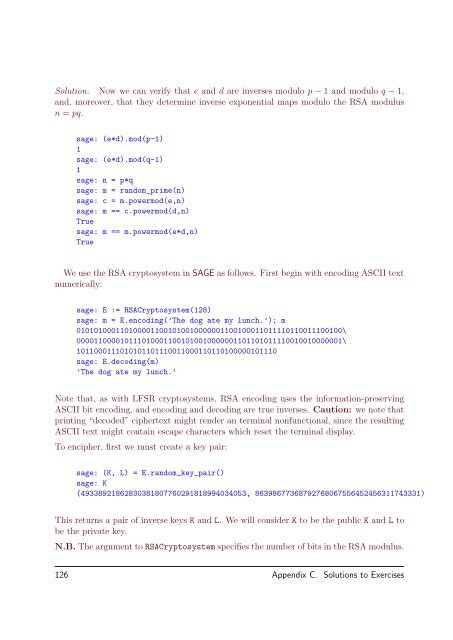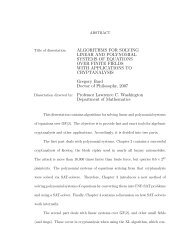Cryptography - Sage
Cryptography - Sage
Cryptography - Sage
You also want an ePaper? Increase the reach of your titles
YUMPU automatically turns print PDFs into web optimized ePapers that Google loves.
Solution. Now we can verify that e and d are inverses modulo p − 1 and modulo q − 1,and, moreover, that they determine inverse exponential maps modulo the RSA modulusn = pq.sage: (e*d).mod(p-1)1sage: (e*d).mod(q-1)1sage: n = p*qsage: m = random_prime(n)sage: c = m.powermod(e,n)sage: m == c.powermod(d,n)Truesage: m == m.powermod(e*d,n)TrueWe use the RSA cryptosystem in SAGE as follows. First begin with encoding ASCII textnumerically:sage: E := RSACryptosystem(128)sage: m = E.encoding(’The dog ate my lunch.’); m0101010001101000011001010010000001100100011011110110011100100\0000110000101110100011001010010000001101101011110010010000001\1011000111010101101110011000110110100000101110sage: E.decoding(m)’The dog ate my lunch.’Note that, as with LFSR cryptosystems, RSA encoding uses the information-preservingASCII bit encoding, and encoding and decoding are true inverses. Caution: we note thatprinting “decoded” ciphertext might render an terminal nonfunctional, since the resultingASCII text might contain escape characters which reset the terminal display.To encipher, first we must create a key pair:sage: (K, L) = E.random_key_pair()sage: K(49338921862830381807760291818994034053, 86398677368792768067556452456311743331)This returns a pair of inverse keys K and L. We will consider K to be the public K and L tobe the private key.N.B. The argument to RSACryptosystem specifies the number of bits in the RSA modulus.126 Appendix C. Solutions to Exercises
















